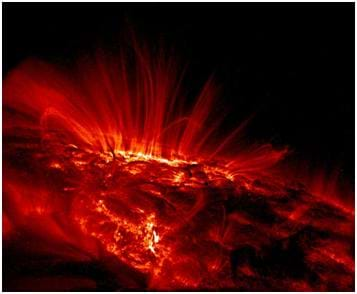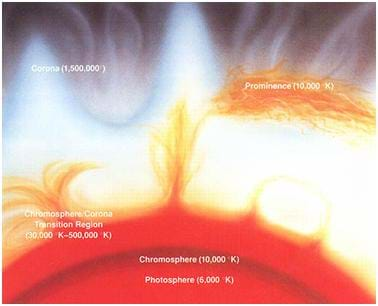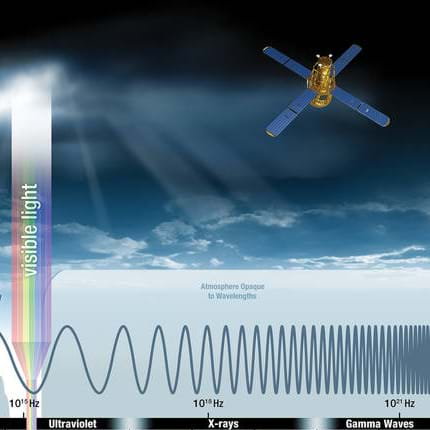Quick Look
Grade Level: 8 (6-8)
Time Required: 45 minutes
Lesson Dependency: None
Subject Areas: Earth and Space
NGSS Performance Expectations:

| HS-ESS1-1 |

Summary
Students are introduced to the Sun by exploring various aspects of it, including its composition, interior workings, and relationship to the Earth.Engineering Connection
Many types of engineers are involved in the space field. Aerospace engineers design and help build airplanes and spacecraft. Other types of engineers, including electrical and mechanical engineers, design, test and install important systems for space bound equipment and ships. Engineers make telescopes, imaging systems and satellites to view the Sun and its events. They also make solar panel collectors and other solar-powered devices used on Earth.
Learning Objectives
After this lesson, students should be able to:
- Explain that energy comes to the Earth from the Sun.
- Describe the role engineers play in learning about space and the Sun.
Educational Standards
Each TeachEngineering lesson or activity is correlated to one or more K-12 science,
technology, engineering or math (STEM) educational standards.
All 100,000+ K-12 STEM standards covered in TeachEngineering are collected, maintained and packaged by the Achievement Standards Network (ASN),
a project of D2L (www.achievementstandards.org).
In the ASN, standards are hierarchically structured: first by source; e.g., by state; within source by type; e.g., science or mathematics;
within type by subtype, then by grade, etc.
Each TeachEngineering lesson or activity is correlated to one or more K-12 science, technology, engineering or math (STEM) educational standards.
All 100,000+ K-12 STEM standards covered in TeachEngineering are collected, maintained and packaged by the Achievement Standards Network (ASN), a project of D2L (www.achievementstandards.org).
In the ASN, standards are hierarchically structured: first by source; e.g., by state; within source by type; e.g., science or mathematics; within type by subtype, then by grade, etc.
NGSS: Next Generation Science Standards - Science
| NGSS Performance Expectation | ||
|---|---|---|
|
HS-ESS1-1. Develop a model based on evidence to illustrate the life span of the sun and the role of nuclear fusion in the sun's core to release energy that eventually reaches Earth in the form of radiation. (Grades 9 - 12) Do you agree with this alignment? |
||
| Click to view other curriculum aligned to this Performance Expectation | ||
| This lesson focuses on the following Three Dimensional Learning aspects of NGSS: | ||
| Science & Engineering Practices | Disciplinary Core Ideas | Crosscutting Concepts |
| Develop a model based on evidence to illustrate the relationships between systems or between components of a system. Alignment agreement: | The star called the sun is changing and will burn out over a lifespan of approximately 10 billion years. Alignment agreement: Nuclear Fusion processes in the center of the sun release the energy that ultimately reaches Earth as radiation.Alignment agreement: | The significance of a phenomenon is dependent on the scale, proportion, and quantity at which it occurs. Alignment agreement: |
Common Core State Standards - Math
-
Fluently divide multi-digit numbers using the standard algorithm.
(Grade
6)
More Details
Do you agree with this alignment?
-
Use ratio reasoning to convert measurement units; manipulate and transform units appropriately when multiplying or dividing quantities.
(Grade
6)
More Details
Do you agree with this alignment?
-
Fluently add, subtract, multiply, and divide multi-digit decimals using the standard algorithm for each operation.
(Grade
6)
More Details
Do you agree with this alignment?
-
Write and evaluate numerical expressions involving whole-number exponents.
(Grade
6)
More Details
Do you agree with this alignment?
International Technology and Engineering Educators Association - Technology
-
Energy can be used to do work, using many processes.
(Grades
6 -
8)
More Details
Do you agree with this alignment?
-
Apply a product, system, or process developed for one setting to another setting.
(Grades
6 -
8)
More Details
Do you agree with this alignment?
State Standards
Colorado - Science
-
Gather, analyze, and interpret data to describe the different forms of energy and energy transfer
(Grade
8)
More Details
Do you agree with this alignment?
-
Identify the distinguishing characteristics between a chemical and a physical change
(Grade
8)
More Details
Do you agree with this alignment?
-
Develop a research-based analysis of different forms of energy and energy transfer
(Grade
8)
More Details
Do you agree with this alignment?
Worksheets and Attachments
Visit [www.teachengineering.org/lessons/view/cub_sun_lesson01] to print or download.Introduction/Motivation
The Sun is a huge, hot, explosive mass that is the center of our solar system. The Sun is so large that a million Earths could fit inside it. The Sun supplies all of our energy, and without it, we would be colder and darker than Pluto. It is about 14 million degrees Celsius at its center. NASA watches the Sun closely, especially for sunspots, solar flares, and coronal mass ejections (CMEs). Although the sun is over 92 million miles from the Earth, these irregularities can affect us here on Earth through radiation (the only type of heat transfer that can travel through a vacuum).
Engineers play a major role in gathering information about space, and especially the Sun. NASA employs many types of engineers in its space program: aerospace engineers design airplanes and spacecraft (with the help of astronautical engineers who work specifically with spacecraft); mechanical and electrical engineers design and build various other components of spacecraft including robotic arms, the computer system (which computer science engineers help program), as well as other vital parts of spacecraft; and civil and chemical engineers play a role in aerospace development, from designing and building the launch pad to determining what kind and how much of fuel to use.
The Sun has an atmosphere that is made up of three layers: the photosphere, chromosphere, and corona. The only visible layer that can be seen with the naked eye is the photosphere. The next layer out is the chromosphere, which, in terms of temperature, is hotter than the photosphere but cooler than the corona. The corona is the hottest and outermost layer of the atmosphere. It is over 1 million degrees Celsius. Humans can only view the corona with a naked eye during a solar eclipse—that is, without the use of a telescope; otherwise, permanent eye damage may occur. Students can learn more about the potentialy harmful effects of the sun with the associated activity UV Radiation: Sunscreen SPF Experiment by investigating the harmful effects of the Sun's UV rays and how to protect themselves from their intensity and harmful effects.
Most of the energy on Earth comes from the Sun, either by its solar radiation or its gravitational pull on our planet (which keeps the Earth spinning and in orbit). Fossil fuels come from plants and animals that used the Sun's energy to live millions of years ago. Newer technologies have allowed us to utilize the Sun's energy directly with the use of solar panels designed and construct by engineers. In addition, they make telescopes, imaging systems, and satellites to view the Sun and its events.
Lesson Background and Concepts for Teachers
Structure of the Sun
The Sun is composed of three layers. The layer we can see with the naked eye here on Earth is the photosphere which is the only visible layer of the Sun. Beyond that is the chromosphere, which is hotter than the photosphere. The corona is the hottest and outermost layer of the atmosphere (but not the hottest layer of the sun). It consists of low-density gas with a temperature greater than one million degrees Kelvin (1 million Kelvin is equal to 999,727 degrees Celsius). To prevent permanent damage to the eye, humans should only view the corona with the naked eye during a solar eclipse.

Unlike here on Earth, the Sun does not require oxygen to be "on fire," as we would like to describe it. In fact, the Sun has a large nuclear fusion reaction that takes place at its center. Like all reactors, fuel is consumed (in this case, hydrogen), and these reactions will not occur forever. The sun is about halfway through its current stage. The reaction is actually the fusion of hydrogen into helium, which takes place at the center of the Sun. As the energy travels through the layers of the Sun over millions of years, the temperature of the energy decreases as it moves farther away from the fusion reactor. Once reaching the surface, this energy circles the Sun in the form of convection currents. It then leaves the Sun and heads out to the rest of the universe. Light, heat and radiation are the forms of energy that leave the Sun. Light takes about eight minutes to reach us here on Earth.
The energy available here on Earth comes from the Sun. Plants utilize this energy (i.e., the Sun) to perform photosynthesis and, therefore, to survive and produce oxygen. Animals then use this oxygen, as well as consume plants, for their survival. Millions of years ago, fossil fuels were formed from decaying plants and animals. As this source of energy is quickly depleted by today's rapid consumption, engineers have searched for ways to sustain our current rate of energy use. Newer technologies, such as solar power (among other alternatives forms of energy), utilize the Sun directly to produce electricity. Engineers play a major role in the design and implementation of technologies such as this.
Solar Activity and Other Information
The great amount of phenomena associated with the Sun and most of the activity on its surface directly affects us on Earth. Sunspots, solar flares and coronal mass ejections are the main active events that we can observe.
Sunspots lie in active regions on the Sun's surface; they follow the same eleven-year cycle of the Sun, and they fluctuate in number. Sun spots are cooler regions of the sun with temperatures of about 3,700 degrees Kelvin (K), but as hot as 5,700 degrees K directly around the spot. The lifespan of a sunspot can be a few days up to weeks for very large spots. Sunspots are similar to magnets in that they come in pairs: a positive and negative one. These spots produce strong magnetic fields that enter the surface of the Sun and add to the natural field of the Sun produced by the flow of ions and electrons.
Solar flares occur as the Sun releases an extreme amount of magnetic energy. Even with our advanced understanding of the Sun and solar flares, engineers and scientists are still unable to predict when these flares will occur. The energy released from a solar flare is equivalent to millions of hydrogen bombs exploding concurrently. The flares can reach up to 100 million degrees K but generally are between 10 and 20 million degrees K. They occur in the active regions on the Sun's surface (around sunspots) and follow the Sun's eleven-year cycle. The Earth's atmosphere is directly influenced by solar flares. According to NASA, solar flares are the most energetic explosions in the solar system. Eight minutes after erupting from the Sun, the energy reaches the Earth and causes the atmosphere to become ionized and expand. As a result, long distance radio signals are disrupted and satellite orbits are disturbed, with possible damage occurring to their electrical components.
Coronal mass ejections, or CMEs, are similar to solar flares and can occur in the presence or absence of flares. CMEs are large bubbles of gas that are ejected from the Sun over several hours and travel at a speed of 2000 km per second. NASA observes 2-3 CMEs a day during a maximum sunspot cycle. CMEs can have catastrophic effects on the Earth and, similar to solar flares, may include a disruption of power and satellites. Outside the Earth's magnetic field, CMEs can cause damage to electronic equipment and astronauts in space.
Associated Activities
- UV Radiation: Sunscreen SPF Experiment - Students learn about the harmful effects of the Sun's UV rays and how to protect themselves from their intensity and harmful effects. They perform a simple experiment and test the effectiveness of sunscreen.
Lesson Closure
Review and discuss the learning objectives. Have students write a reflective paragraph on the topic "what would our lives be like without the Sun." Have students volunteer to read their paragraphs aloud. If it does not come up in the paragraphs, ask students if life would be possible without the Sun. If other stars in the universe are similar to our Sun, does that mean life may exist in other places? Questions like this help students begin thinking about the inner workings of our universe. If time permits, incorporate the lesson summary assessment into the closure.
Vocabulary/Definitions
chromosphere: The layer of the Sun between the photosphere and the corona.
convection: Heat transfer by current circulation in a gas or liquid.
corona: The outermost layer of the Sun with a temperature greater than one million degrees K.
coronal mass ejection : Ejections of gas from the Sun that may disrupt power and electrical equipment here on Earth.
photosphere: The visible layer of the Sun; cooler than the other two outer layers.
solar flares: An explosion of gas and magnetic energy on the surface of the Sun; normally occur around sunspots.
sunspot: Cool, dark spots that appear periodically on the Sun's surface; strong magnetic fields normally occur at the spots.
Assessment
Pre-Lesson Assessment
Brainstorming: As a class, have the students engage in open discussion. Remind students that in brainstorming, no idea or suggestion is "silly." All ideas should be respectfully heard. Take an uncritical position, encourage wild ideas and discourage criticism of ideas. Have them raise their hands to respond. Write their ideas on the board. Ask the students:
- What tools do engineers and scientists use to view and learn about the Sun? (Possible answers: telescopes, high-powered imaging systems, satellites)
- How big is the Sun? (Answer: Large enough for a million Earths to fit inside it.)
- How far away is the Sun from the Earth? (Answer: 92 million miles)
- How long does it take light to travel from the Sun to the Earth? (Answer: eight minutes)
- What produces the extreme temperatures of the sun? (Answer: Fusion reactions at the core of the sun.)
- How does the energy from the sun reach us here on Earth? (Answer: Energy is transferred to us via light, radiation, and convection [solar winds].)
- How old is the sun? (Answer: 5 billion years old)
- Do we know how long the sun will be around? (Answer: Yes, we can roughly calculate how much "fuel" the sun still has. At its current "hydrogen-burning" stage, the sun is expected to last another 5 billion years. Following this, the sun will burn helium and expand into a red giant.)
Post-Introduction Assessment
Idea Web: Ask students to brainstorm a list of activities we could not do if there was no Sun. What effects would the lack of these activities have on our daily lives? Could you live without the Sun? Encourage the students to build off of the other ideas. Have them create the idea web on the chalk/white board.
Lesson Summary Assessment
- Worksheet: Have the students complete the attached Our Amazing, Powerful Sun Worksheet in groups of two (each completing their own). Answers can be found in the Our Amazing, Powerful Sun Worksheet Answer Key.
- Pass the Buck: In groups of four, have students brainstorm ideas to design the ultimate renewable energy system. First, assign one student in the group to be the recorder. Then, have someone toss out an idea. Next, another person in the group provides an idea that builds on the first. Go around the group in this fashion until all students have put in enough ideas to put together a design. When they are done, have them share their idea(s) with the class. Encourage the incorporation of any current renewable energy systems (solar power, wind power, etc.) that they have learned about in other classes or past lessons. This can also be a fun exercise as an entire class.
Subscribe
Get the inside scoop on all things TeachEngineering such as new site features, curriculum updates, video releases, and more by signing up for our newsletter!More Curriculum Like This

Students are introduced to our Sun as they explore its composition, what is happening inside it, its relationship to our planet (our energy source), and the ways engineers help us learn about it.

Through role playing and problem solving, this lesson sets the stage for a friendly competition between groups to design and build a shielding device to protect humans traveling in space. The instructor asks students—how might we design radiation shielding for space travel?
References
National Aeronautics and Space Administration, Solar System Exploration, http://solarsystem.nasa.gov/multimedia/display.cfm?IM_ID=107
National Aeronautics and Space Administration, Goddard Space Flight Center, "Solar Flare Theory," August 1, 2007, accessed March 17, 2009. http://hesperia.gsfc.nasa.gov/sftheory/index.html
National Aeronautics and Space Administration, Marshall Space Flight Center, Solar Physics, "Sun Facts," March 4, 2009, accessed March 17, 2009. http://solarscience.msfc.nasa.gov/
National Aeronautics and Space Administration, Heliophysics Science Division, NASA's GSFC, "Cosmicopia an abundance of cosmic hars", June 18, 2012, accessed January 3, 2014. http://helios.gsfc.nasa.gov/qa_sun.html
Cornell University, Astronomy Department, "Ask an Astronomer", November 11, 2002, accessed January 3, 2014. http://curious.astro.cornell.edu/question.php?number=389
Copyright
© 2009 by Regents of the University of Colorado.Contributors
Brian Kay; Jessica Todd; Geoffrey Hill; Jessica Butterfield; Janet YowellSupporting Program
Integrated Teaching and Learning Program, College of Engineering, University of Colorado BoulderAcknowledgements
This digital library content was developed by the Integrated Teaching and Learning Program under National Science Foundation GK-12 grant no. 0338326. However, these contents do not necessarily represent the policies of the National Science Foundation, and you should not assume endorsement by the federal government.
Last modified: September 23, 2020







User Comments & Tips